“To love someone is to feed them well.”
Unknown
Nothing says “I Love You” like good food!
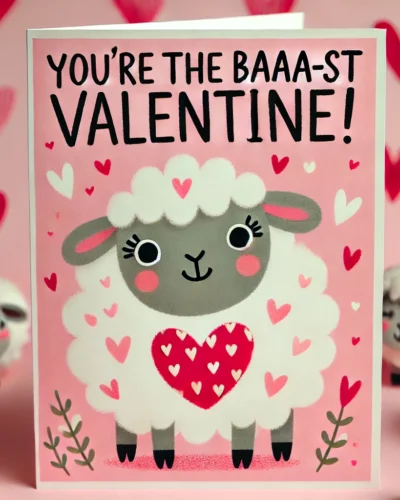


“To love someone is to feed them well.”
Unknown



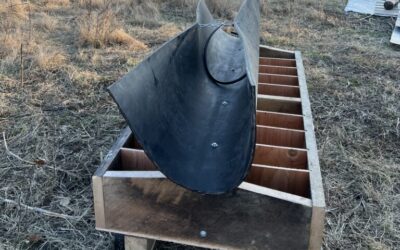
“Minerals are the spark plugs of life.” — Dr. Linus Pauling
“You are what you eat eats.” — Michael Pollan
“Minerals are the cofactors that make our cellular machinery run; without them, our biochemistry simply doesn’t work.” — Dr. Casey Means
At our farm, we are always looking for ways to improve the health and well-being of our sheep while also delivering the highest quality products to our customers. That’s why we recently invested in the 20-mineral feeder from Free Choice Minerals. This carefully formulated supplement provides our flock with essential nutrients that promote optimal health, growth, and vitality. But what does that mean for our customers? Better quality, nutrient-rich meat that is both delicious and wholesome.
Sheep, like all animals, require a balanced intake of minerals and vitamins to maintain their overall health. Deficiencies in key nutrients can lead to poor growth, weakened immune systems, and lower-quality meat. With the 20-mineral feeder, our sheep can choose the precise nutrients they need, ensuring they grow strong, stay healthy, and produce superior meat.
This mineral feeder includes a comprehensive blend of essential minerals and vitamins that work together to improve the well-being of our flock:
A well-balanced diet translates directly into the quality of the meat we provide. With proper mineral supplementation:
By implementing the Free Choice Minerals program, we are reinforcing our commitment to raising healthy livestock and delivering premium meat to our customers. We believe that the best way to produce high-quality, nutritious food is by ensuring the well-being of our animals.
When you choose our farm’s lamb, you’re not just getting delicious meat—you’re getting a product raised with care and the best nutritional support available. Taste the difference that proper mineral nutrition makes and enjoy meat that’s as good for you as it is for the environment!
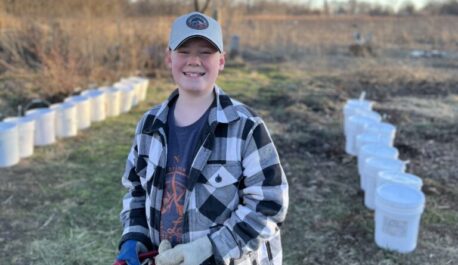
We’re also improving the soil by the sheep re-mineralizing the soil. “The soil is the stomach of the plant, and if we don’t feed the soil properly, it won’t be able to nourish the animals or us.” — Joel Salatin
The main agroforestry event I look forward to every year is the Forest Keeling Fall Field Day, because I can learn and buy trees in the same day! This September 22nd, Owen and I drove into the great state of Missouri to learn about clean water, native trees and plants, and big movements that are making the world a better place to live.
Since building ponds at The Shire this summer, I was particularly interested in these topics. Our ponds were finished on Monday, July 25th, the day before a record 10″-12″ rain. Our ponds filled up in one day, but that left deep ruts in the banks of our new, beautiful ponds. We knew that we had to do something to stabilize our banks from future storms.

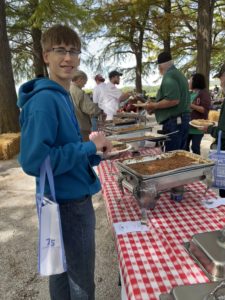

Chad started off the day with a phenomenal story of perseverance in cleaning up the rivers in the Midwest. I recommend watching his story. It shows that anyone can make a difference, but it won’t be easy.

I enjoyed hearing about the ways Missouri is shoring up waterway banks in order to minimize erosion. I once talked with a landowner who planted trees on his side of a large creek, but his neighbor did not. Over 10 years, the creek slowly eroded the neighbor’s land but not his own. These small and large projects are so important to keeping the land productive, as we’ve learned on our own land. Water is life, but in large quantities, it is destructive. One main goal of permaculture is to slow, spread, and soak water into the landscape.

Alan’s talk was the most practical for me. I loved learning about specific plants and their uses. Each generation needs to learn the breadth of diversity available in order to best steward our natural resources. One of my favorite persons on this is Eliza Greenman, dubbed “The Indiana Jones of Agroforestry“. She travels and searches for the best cultivars to utilize in agroforestry systems.

Just like your finger nails, sheep hooves grow all the time and need trimming periodically. We typically trim hooves in July when males are split from the females to minimize our handling work, but this year, due to building ponds, we were delayed. It’s also a nice time to inspect the sheep and count males/females. This year we’re currently sitting at 16 males, including our ram and 32 females. We started with 20 females and a ram, so we’re doing good on our male to female ratio this year.
Just a reminder that we post lots up updates on how things are going on our social media pages, so make sure you subscribe on Facebook (@MiddleEden) or Instagram (@MiddleEdenFH).


We will be taking lambs to butcher the end of November, so if you are interested in the best lamb available, make sure to reserve yours today. Also, sign-up for our newsletter, so you will get updates when our products become available.
are very necessary for raising baby trees with sheep, to keep the sheep from grazing the new shoots before they are taller than the sheep can eat. When we started our main tree planting, we ordered five foot tree tubes for the large trees (Pecan, Oak) and three foot tree tubes for the smaller trees/bushes (apple, hazelnut, persimmon, pawpaw). The issue has been that sheep can definitely eat above three feet, so we’ve struggled to keep them from eating off the tops of the small trees/bushes. The apple trees made it above browse line a white ago, but they really seem to like hazelnuts. Last year, I tried something I’ve seen where I used two five foot tubes as a wider tube around the hazel nuts, and we’re getting hazelnuts off those this year! The other success we’ve had is the oaks growing almost too large for the tubes. This has caused some leaf/grass litter to build up in the tubes and keep moisture near the trees, causing them to fill up with ants under the bark.
This weekend, I took all the tubes off the oaks to free them up to keep growing and reuse around more hazelnut bushes. We’re looking forward to hazelnuts this fall!
To the right is a picture of the original tree planting. Below, from left to right, are a baby hazelnut, wasp and spider nests in a tree tube, and a picture of our sheep, getting fat on the weeds this summer.
As a side note, we really do love the spiders. Trees with spider webs is a premium method to control flies.




We are in a period of planning and planting, adding new pick your own crops that can be raised without spraying poison at The Shire. If you live in the area and have crops you would want to pick, please send us a note!
The last couple of weeks have seen heat advisories and heat indexes over 100 degrees F. That is a real issue when you have animals outside. How do we deal with the heat at The Shire?
Our main tool for dealing with the sun is shade! We don’t have just one tree that every animal clusters under like some farms you might have seen. We have built in rows of trees so that animals are NEVER without shade. Trees not only provide shade, but they also release water vapor into the air. Under trees can be 10-15 degrees cooler than out in the sun as well as preventing sunburns from direct exposure.
In addition, we have to stay vigilant to keep water filled. Animals do drink much more water than usual during these hot temperatures.

Cooler temperatures for animals is only one of the many rewards of agroforestry. The person who has inspired me the most on agroforestry has been Mark Shepard. (You can read about my opportunity to hear Mark Shepard in person by clicking here.)
Our first big project after purchasing The Shire was to plant 100+ trees: oaks, pecans, apples, hazelnuts (more of a bush), pawpaws, persimmons, mulberries, and honey locust. Those trees are now starting to provide rewards of shade and produce their fruits, but we are still several years away from hitting substantial production.
This year should be the first year we harvest hazelnuts and apples. There won’t be a large quantity, but we’re hoping that it is a sign of things to come.



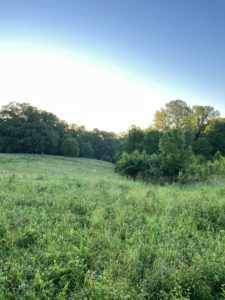

With today’s ice and tomorrow’s snow forecast, we are grateful for a shed full of hay and enough room for the flock to wait out the weather in a dry shelter. Preparations began months ago, and we continue to work to keep everyone as comfortable as possible. Last night was spent unrolling hay and stacking it in the shed to maximize bedding area and simplify feeding.

When you think of sheep, you probably think of wooly sheep that need to be sheared, but not all sheep grow wool! Our sheep are referred to as “hair” sheep, but all sheep have hair and wool. Hair sheep just have more hair than wool. This means that like many dog breeds, their coat grows thicker during the winter and is shed in the spring. Their hair/wool is also covered in lanolin oil that keeps their skin protected and their coat dry. Hair sheep breeds also come with many more positive qualities, including lower maintenance (no shearing), high level of reproduction, are more resistant to internal parasites (worms), and more tolerant to heat and humidity.

As any livestock guardian knows, water is probably the most troublesome issue during colder weather. We have long been unable to use our outdoor faucets due to the temperatures, so we now carry very warm water twice a day to maximize fresh water availability to the flock. Sheep can go for weeks with little to no water when their forage is fresh, but when feeding on hay, they tend to drink more because of the dry hay.
All this talk of winter maintenance has me dreaming of spring. I’ll probably go browse some greener pictures over on our facebook page: https://www.facebook.com/MiddleEden/
Also, if you missed our special newsletter update today, make sure to sign up now, so you get all our future newsletters!
are magical. They are systems that take on a life of their own and require minimal maintenance after planting. Before we ever started at The Shire, I started a permaculture design company called Regenerative Landscaping. Our house was the first and only Illinois house to be featured in the St. Louis Sustainable Backyard Tour. In our small Fairview Heights backyard, we raised ducks, chicken, and bees. We also planted about 40 feet of blackberries and 20+ fruit trees. When we had a chance to move closer to The Shire, we were so sorry to leave our yard behind.
This year, we have big plans to start planting an even larger food forest at the Shire. We are planting a 1/5 acre food forest to act as a nursery for filling the rest of The Shire. We are putting in 8 apple trees (Liberty, Golden Delicious, and Granny Smith), 4 pears (Elberta and Early Elberta), and 3 cherry trees(Montmorency, Bing, and Rainier). In addition to that, we are planting 120 blackberry plants that will stretch for 350 feet.
We are excited to see them grow and start producing food for our community!



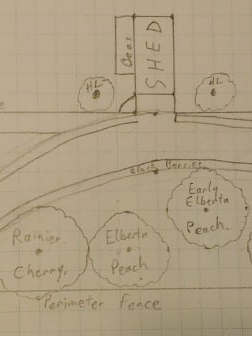

an agroforestry system was a keystone part of our plan for The Shire. In the spring of 2016, we started planting the backbone of our agroforestry system: 10 plantings, each containing a grafted pecan, 3 oaks, 2 persimmons, 1 pawpaw, 4 apples, and 8 hazelnuts. The ultimate goal is to create a savanna that supports a diverse set of animals including sheep, pigs, chickens, ducks, and bees.
weren’t always part of our vision, but in 2015, we picked up our first sheep with our minivan. We started with Barbados Blackbellies because of their parasite resistance and ability to forage well. We eventually added Katahdins to increase their finishing size. We chose to raise sheep for several reasons. Unlike cattle, sheep are a manageable size to raise without special infrastructure. We needed animals that would be easy on the trees. Cattle would easily push over trees and goats eat trees. Sheep have a long history of grazing under orchards. Finally, when a ewe weans her twins, she has essentially doubled her weight in one year, which is a very productive increase.


captures our vision for our farm. Like J.R.R. Tolkien “I am in fact a Hobbit (in all but size). I like gardens, trees and unmechanized farmlands; I smoke a pipe, and like good plain food; I like, and even dare to wear in these dull days, ornamental waistcoats. I am fond of mushrooms (out of a field); have a very simple sense of humour; I go to bed late and get up late . I do not travel much.”
We have many more plans for The Shire’s future. Sign up for our newsletter to get updates on our progress.